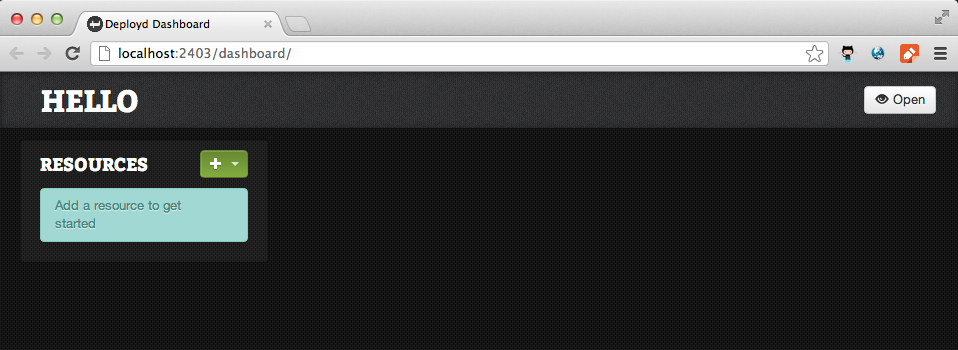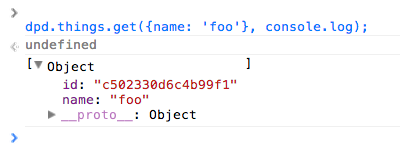What kind of deployd beast and why you can love it with the first click
My 5 kopecks
I'm still a very beginning web developer - as I understand it myself, although I know javascript quite well, I use (I’m playing), using different frameworks like bootstrap, jQuery, Webix, I smell Node.js and NoSQL databases, I try different versions of storage services bundles danyh out of the car (Firebase), but here's how to start, do something your own, and not stupidly repeat different versions-options of ToDo-nis, as it did not work.
I eat bread from a different area, so all of this is a hobby for me, although I like programming in C # and VB and there are a couple of projects successfully implemented and I have different ideas that I could do, but here’s how that magical kick in the sirloin to take the first step - and just the other day I discovered DEPLOYD!
I eat bread from a different area, so all of this is a hobby for me, although I like programming in C # and VB and there are a couple of projects successfully implemented and I have different ideas that I could do, but here’s how that magical kick in the sirloin to take the first step - and just the other day I discovered DEPLOYD!
Since I did not find a reference to Deployd on Habrahabr, I rush to fill this gap with a small translation from the official site, in the hope that for some it will also be useful to learn about such a simple and reliable tool that can be easily applied not only to beginners ( like me), but also serious uncles. So, welcome!
Deployd - the easiest way to create your own IPA
It's just one, two ... well, actually, you will understand everything:
')
1. No boilerplates
All in one command, you can run your API. This is an absolutely empty container, which is just waiting for you to fill it with resources. Works out of the box - additional code is optional.
2. Resources
The Deployd API implies the use of a ready-to-use Collection, as a resource that can be easily defined and defined through the built-in control panel.
3. Control Panel
Add and manage your API resources through the intuitive web-based control panel interface.
4. Development in 1 step
When it comes time to deploy your application, you can deploy it yourself to any service that supports Node.js and MongoDB.
It sounds nice, but what is actually under the hood? And let's see:
In the presence of an installer for the MAC and under Windows and also attached source code with a link to the githab.
Installation under Windows has been reduced to clicking on the next, next, ok, ok, no bars or other integrated shnyagi in the installer,
You can check what has been installed by a simple command from the command line:
dpd -V In response, it will produce something like: 0.8.0 (I tried to upgrade to 0.8.4, but there’s something not ready yet - access to Mongo flies)
Create your first project as 2 bytes to send:
dpd create my-app
for those wishing to use a clean Node.js there is a bag in the same way:
npm install deployd -g
For those who like to do everything according to Feng Shui, there is an opportunity to greet the world as usual:
dpd create hello-world
cd hello-world
dpd -d
After that, in the directory where the console pointed at the moment of launch, a hello-world daddy will be created and after the last command you will see the

From the drop-down list next to Resources, select Create a new collection and give it a name / things
set the name property - case sensitive! Kirilitsu does not support unfortunately and may fortunately
By the way, many pages in the control panel have their own hotkeys.
Now add some data to your collection by opening the data editor and in the window that opens, double click in the input box next to the asterisk. Beat in “foo”, enter, “bat”, enter, “baz”, enter.
You should look like:

By clicking on the API menu, you can see all available methods for accessing your collection. If you open localhost : 2403 / things in the browser, you will see the following JSON:

Now in your browser, open localhost : 2403 and call the console. Try the following:
dpd.things.get(console.log); dpd.things.get({$limit: 1}, console.log); dpd.things.get({name: 'foo'}, console.log); In response, you will see something like:

How and what actually happens "live" can be viewed on the video from the creators, which shows the creation of a small application, duplicate it here:
The video tag does not work for some reason, try to look at the link .
The documentation also gives an example of creating an application for the conclusion of comments, because of its ordinariness and simplicity, I decided that it is too simple and uninteresting for it to be analyzed in detail in the framework of this article.
It is also expected to launch deploydapp.com soon, which promises a platform for hosting its own created APIs.
I hope you liked the soft and intrigued, and probably not one rushed to create your own API with its help, at least I hope so.
All the best and see you soon!
Source: https://habr.com/ru/post/260109/
All Articles